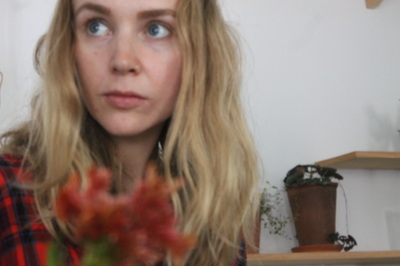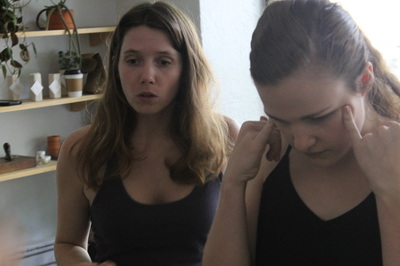|
1. Ginny (Rose Stewart - See past posts on our work together) was on my mind all day as I worked a couple weddings Saturday with Ferncroft. I try very much to lay in the background during production until things get intense near deadlines. I see myself as just there to help and offer support doing little things that fall off the back because they aren't top priority - I sweep the floors, take some process images, and do my best to open up my full range of horticultural humor.
Never a moment for "just play" of course, my camera work was approached as a methodological exercise. Ginny spent a lot of time with us this week, I bet I talked to her everyday, and surely this led me to be thinking about "bodies," something I always steer away from as my concern is generally with artifacts and plant material. CONCLUSIONS: (A) I'm not sure how Ginny - or anyone - does live shoots of people working. Everything is a blur from the movement. Obviously there is an answer, but it is one that must become "disciplined" or unconscious so the tool (camera) can be operated with the same smoothness of the bodies its gaze is fixed on. My operation is too cumbersome; I do not yet have the dexterity to be in step with "Ferncroft." Here we may speculate about a rhythm, tempo, or meter that a skilled person operates at in their craft - and a photographer must be able to match this intensity if she wishes to catch the image. (B) My suggestion that I have focused on "artifacts" as opposed to "bodies" or "persons" maintained a methodical seperation right through the editing process. Only after selecting my images to share here and uploading them into a "file" so to speak, did I see the idea they are not seperate things and that I think we lose a lot in the - what I'll call - the "critical floral world" when cameras are focused on the curation of individual works and not on the work, worker, and works together. They themselves are a collaboration. 2. I never saw faces and bodies as much as I did through the camera yesterday. For whatever reason, without the aid of this tool, I always look off into the distance. In this, we may think of "aperture, affect, and attention" as things to think about together. 3. Note on "Branding:" When artists and "makers" are in production - they don't smile. 4. Spending the day with Ferncroft, conversation often steered to the anxiety we all have of "not making it" (my words). This is "the voice" I speak of in the title. I think this anxiety is a constant in those whose lives are composed around their craft. In "Branding," this real complication of course is hidden and cast behind the curtain of production. "Artists" or "makers" - in something that should be voiced more, or articulated - aren't merely "making things that look nice;" to arrive at different finished works they must take on different modes of production which are seen as non-conventional and therefore are accompanied with high levels of risk. Risks makers carry on their shoulders, emotionally, with identities on the line - burdens bared in the name of "I think the world should be this way and I'm going to try and make it so." Next time I see Ginny, I'm going to talk to her about this. Comments are closed.
|
Matthew DoreLandscape designer and Proprietor of Buffalo Horticulture Archives
April 2020
Categories |
Telephone(716)628.3555
|
|











 RSS Feed
RSS Feed